Best Wireless Access Points in 2024

Wireless access points aren’t as popular as routers, but they’re still quite widespread in the business sector. When you have lots of employees on top of numerous visitors, all using Wi-Fi, range extenders and mesh Wi-Fi systems just can’t cut it. Wireless APs are also handy for large homes since they have better wireless coverage than most long-range routers and can cost you less than a mesh Wi-Fi setup. For these reasons and many others, finding the best wireless access point for your particular needs can be quite tricky.
This is why we’ve created our list of the best wireless access points. Here you’ll find budget models but also APs that support hundreds of users and come with ultra-fast speeds. We’ve included both Wi-Fi 5 and Wi-Fi 6 models, as well as APs with and without PoE. Finally, we also have one model that can act as an AP or router. Let’s begin.
Best Wireless Access Points
NETGEAR WAX206
The Solid Netgear Option
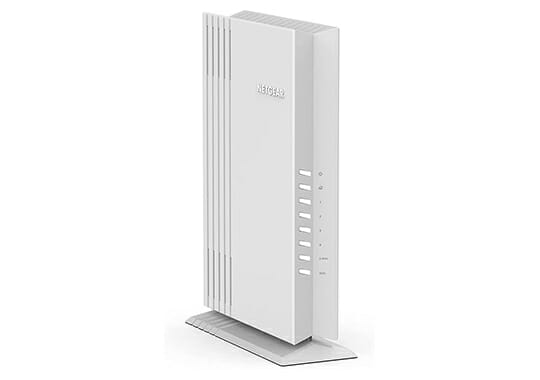
- 2.5 Gbps WAN
- WiFi 6 AX3200
- MU-MIMO, 802.11ax
Setting up a fast and secure extended network is pretty easy to do when you have great hardware like the Netgear WAX206 access point. The WAX206 supports WiFi 6 AX 3200 and can take up to 128 maximum devices at the same time.
It can do up to 2.5 Gbps and even has 4 Gigabit ports for wired devices that cannot access the wireless network. At the same time, the WAX206 can deploy 3 separate networks with different purposes allowing you more granular security of your devices.
Getting the device ready is also an easy task since all you have to do is use the Netgear setup wizard and plug the device in. Overall a solid experience.
- Easy to set up and use on your home network
- 2.5Gbps maximum speed is more than enough
- 4 Ethernet ports are welcome for wired devices
- This is technically a router/access point combo but the routing is very limited
- No 2.4GHz WiFi 6 support only basic 2.4GHz
- In some instances you will need a Netgear account to set it up – some people managed to get it to work without it
TP-Link EAP610 V2
Ceiling Mounted Access Point
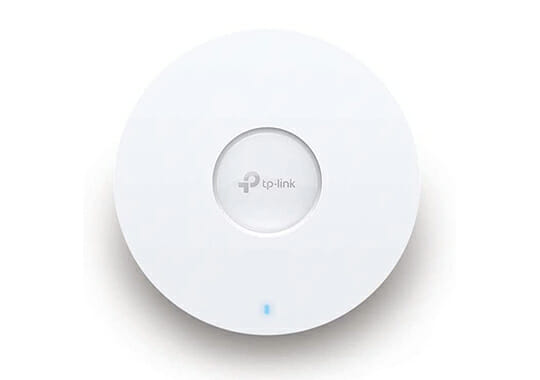
- Wifi 6 AX1800
- Omada SDN integration and Omada app
- Supports Mesh WiFi and Beamforming technologies
Having routers and access points scattered around your house creates unnecessary clutter, so that is why certain people might like the idea of having ceiling-mounted access points, that are hidden away from your sight.
The TP-Link EAP610 V2 is a WiFi 6 AX1800 ceiling-mounted access point that will get you an extended network with up to 1800 Mbps. This device comes packed with all sorts of advanced features like Omada SDN which allows you to integrate network devices such as access points, switches, and gateways.
With the Omada app, you also get centralized cloud management of all of your devices being able to monitor them whenever you want from wherever you want. Overall this access point will allow you to create a solid extended network without any hassles.
- Is small and can be easily hidden around your office or house
- It will help you gain range and speed for your local network
- The Omada features add quite a bit of value
- To unlock the full potential of the device you are forced into using the Omada options
- A bit more expensive than the competition with similar specs
NETGEAR WAX214
Inexpensive Access Point
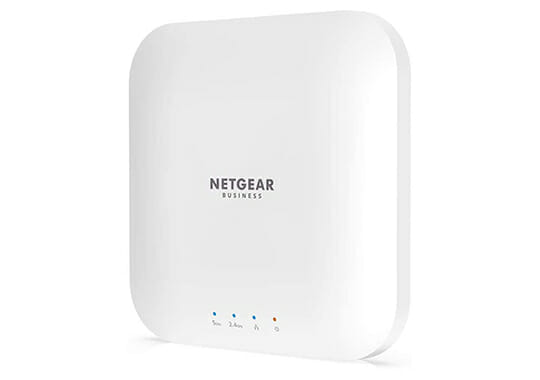
- AX1800
- WPA, WPA2, and WPA3
- MU-MIMO
If you want to extend the range of your local WiFi without spending a lot then you could try the Netgear WAX214 access point. This is a very simple but effective way of extending the capabilities of your current network.
The WAX214 is a Dual-Band AX1800 access point that supports MU-MIMO technology and can take up to 128 devices at the same time. The device also supports WPA, WPA2, and WPA3 for increased network security. You can also have up to 4 separate networks dedicated to different tasks like gaming, working, watching videos, etc.
The setup is simple since you can use the Netgear setup wizard making the overall experience of using this access point as straightforward as possible.
- A small and compact device that can be used anywhere
- Easy setup process
- Decent hardware capabilities
- The setup process can be a bit annoying if you do not have a Netgear account
- The setup might require you to be connected to the internet
Ubiquiti UniFi UAP-AC-PRO
The Best Wireless Access Point For Home And Small Offices
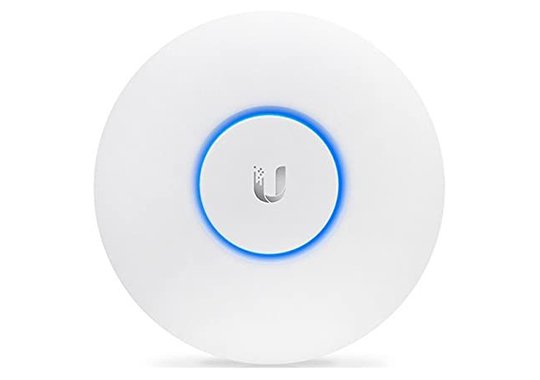
- Wi-Fi Support: Up To Wi-Fi 5
- Bandwidth: 450Mbps (2.4GHz); 1300Mbps (5GHz)
- LAN Ports: Yes, Two 1Gb LAN Ports
- PoE: Yes
- Maximum Number of SSIDs: Undisclosed
If you want an access point that’s simple to set up and just works in 99 percent of the cases, get the Ubiquiti UAP-AC-PRO. It supports Ubiquiti’s Unify network system that makes adding new devices easy. Unify comes with advanced management features, and a number of extra options. The device itself supports PoE, features dual-band support (450Mbps 2.5GHz, 1300Mbps 5GHz), 3×3 MIMO, and is weather resistant making it one of the best outdoor wireless access points.
Speed is near the advertised numbers, the range is great, with this AP being a great starting point for building a WAP network. Downsides include the high cost of building such a network as well as potential issues during installation if you’re not used to dealing with Ubiquity devices. You also don’t get Wi-Fi 6 support.
- Simple To Set-Up If You Have Experience With Ubiquity
- Seamless Integration Into Ubiquity Unify System
- Great Range
- Can Be Difficult To Set Up If You Never Used Ubiquity Products
- A Bit Expensive
- Lacks Wi-Fi 6 Support
Zyxel NWA50AX
WiFi 6 Access Point
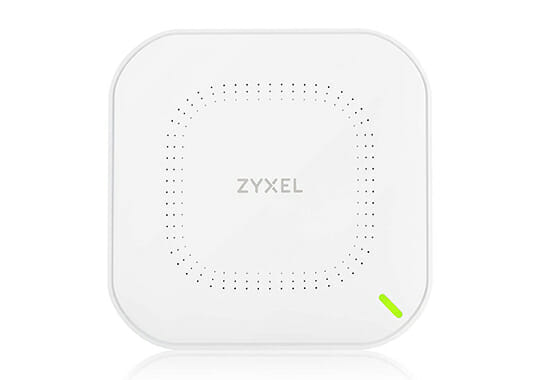
- WiFi 6, AX1800
- WPA3
- Dual 2×2 MU-MIMO
Extending your WiFi 6 network is easier than ever because there are a lot of cheap access points that support WiFi 6 on the market. A good example is the Zyxel NWA50AX WiFi 6 access point that supports AX1800 with Dual 2×2 MU-MIMO.
This device is excellent for your home or business network since it has WPA3 security and it is easy to install and manage with the Nebula app. You can connect up to 256 devices to one NWA50AX access point making it a reliable device for many users.
Overall it is easy to use and manage the Zyxel router due to the excellent standalone and cloud management services ensuring your access points are working just like you want them to.
- This is a WiFi 6 access point which means you will get great speeds
- The installation and configuration are simple
- Managing the access points is also extremely simple
- Manages to beat or rival most brand routers with the same specs for cheaper
- Weaker signal strength in certain conditions
Linksys LAPAC1200C
Solid WAP For Smaller Spaces
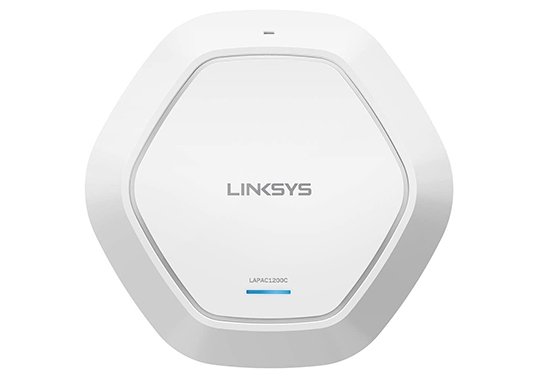
- Wi-Fi Support: Up To Wi-Fi 5
- Bandwidth: 300Mbps (2.4GHz); 866Mbps (5GHz)
- LAN Ports: Yes, One 1Gb LAN Port
- PoE: Yes
- Maximum Number of SSIDs: 8
The Linksys LAPAC1200C is a Wi-Fi 5 WAP that’s great for smaller spaces, but not as great as a base for a larger WAP network. Since there are multiple reports of Linksys dropping support for current products after only a couple of years, we cannot recommend this AP to users who plan on expanding their network in the future. Everyone else will get a reasonably fast AP that’s easy to set up and has competitive price.
As for the specs, the WAP comes with dual-band support (300Mbps over 2.4GHz, 866Mbps over 5GHz), local cloud management, eight unique SSIDs, guest mode, assisted roaming, and advanced security features. The range is pretty good. When it comes to downsides, aside from the support issues this AP isn’t a speed champion. Also, by default the AP isn’t set at full power, which may lead to a weaker wireless signal.
- Great Range
- Easy To Set Up
- Supports Up to Eight SSIDs
- Isn’t Great As A Base For WAP Network
- Can Have Signal Issues
- Comes With Only One LAN Port
- Many APs Come With Faster Speeds
How To Choose A Wireless Access Point
If you’re a business user there are lots of variables to account for when planning to buy a new wireless access point. If you already have WAPs in your offices the new one has to work fine with the existing ones. Next, there’s the question of futureproofing and whether the new WAP can handle a potential increase in users. Then there’s the guest mode, the question of how many SSIDs you need to set up on each WAP, and more.
Home users, on the other hand, usually want a simple, worry-free, and fast setup as well as great Wi-Fi range. For larger homes, multiple LAN ports could be a major plus. Next, when you’re picking a WAP for your home, you don’t want to overspend because you easily can. Also, APs can be handy for creating multiple SSIDs to control bandwidth on different sets of devices, in case you’re data limited. Finally, while cloud control is desirable in the business market, home users prefer local AP control. Let’s cover each of these points in detail.
Local And Cloud Management
You want an AP that’s easy to use, set up, and manage. It’s always a plus when an access point supports standalone management via web UI instead of requiring users to create online accounts and access an AP they own exclusively via the cloud.
The best case is the combination of local and cloud management. This way you can stay local and use your web browser if you’re a home user or at work, and switch to the cloud when needing to manage the AP when on-field or out of work.
Get An AP That Can Handle Increase In Users
This is an extremely important thing to consider, especially if you’re buying multiple APs at once. They aren’t cheap and can be a pain to replace with new ones (especially if you change manufacturer) so calculate a potential future increase in users and make sure your next AP or APs can handle it.
Make Sure You Get An AP From Manufacturer With Great Product And User Support
Not only your next AP should be able to handle potential increase in users, but it should also come from a manufacturer with great product and user support record. There’s a good chance you’ll run into issues so responsive and helpful user support is a must.
Next, we have product support. You don’t want to get an access point that has limited support or one that will have its support dropped after a year or so. Wireless access points usually target businesses and you don’t want to get a device that won’t work with future AP models from the same brand. Because, in that case, either get ready for regular upgrades or switch the supplier.
Assisted Roaming Can Be A Godsend In Larger Homes And Offices
Assisted, or seamless roaming is a very handy feature to have in an environment covered by multiple access points. It makes switching from one network to another seamless and without a single signal drop. Great for online-oriented businesses where constant internet connection is a must. Imagine dropping from an important Skype meeting just because you had to switch offices and APs.
Home users don’t usually require assisted roaming since most APs can cover an entire home singlehandedly. But if you have a larger house with multiple APs, seamless roaming is definitely one of the features you should look for in your next wireless access point.
Guest Mode And Ability To Create Multiple SSIDs Are Important
If you have a business, especially retail or a venue business, the guest mode is a must. Now, most APs do support this feature but you shouldn’t take it for granted. It’s better to be safe than sorry.
In addition to the guest mode, you also want the ability to create enough SSIDs to suit your needs. This is where you should talk with your IT personnel or the company that handles your IT needs and ask them how many different SSIDs they prefer having. If you’re a home user without lots of devices, even two SSIDs (one for the regular and one for the guest network) should be enough, in most cases.
If you, for instance, have a limited internet plan, the ability to create more than two SSIDs could massively help you in controlling your data consumption. Hooking different devices to different networks, each with its own speed and data caps is the best way to monitor and limit data consumption for every connected device in detail. More than two SSIDs are also great if you want to create a separate network for your children, with parental control, or for any other use case where you need more than two Wi-Fi networks.
If You Need LAN Ports, Make Sure The AP You’re Looking To Buy Has Enough
Most wireless access points come with two LAN ports, or one WAN and one LAN port. One port will always be used for connecting to a router or server so you’re usually left with one port for a wired LAN connection. But some APs come with just one LAN port, or more than two LAN ports.
If you don’t need an extra LAN port, going for a one-port AP could save you some cash. On the other hand, if you need more than one LAN port for your devices, make sure to do your research before ordering a new AP. Home users should also look out for LAN ports, especially if your router is in an unreachable place and you’re using a WAP to connect your devices to the Internet, among which are desktop PCs.
PoE Can Make Installation Much Easier
Power over Ethernet allows certain APs to use the Ethernet cable both for data and power. This is a must for most businesses because it greatly simplifies installation. Instead of two cables and a socket for the power adapter, you only need access to an Ethernet cable.
If you’re a home user, PoE may be important if you’re using a WAP in your backyard where there are no power outlets, or for various other reasons. Maybe you have an outlet outside but don’t want to risk getting it wet; or you don’t have space for two cables during installations.
Whatever’s the case remember that most wireless access points come with the PoE feature but not all of them support it. Further, there are multiple PoE standards. Not all APs support PoE+, which is needed for an 802.11ac-based network (Wi-Fi 5). Research is recommended before pulling the trigger.
Not All APs Are Made For Outdoor Use
Wireless access points are great for outdoor use. They usually have a much better range than most modems, can work only with an Ethernet cable, can be managed via the cloud in most cases, and support multiple SSIDs in case you’re sharing a connection with a neighbor, or a neighboring venue in case you’re a business user.
The issue is that most APs aren’t weather resistant. They can break if left out in the open and they definitely hate rain. So, make sure you get a wireless access point that is certified for outdoor use. Even if the AP is protected from the elements, it’s best to get weather resistant; if it’s outdoor it can get wet no matter how well protected it is.
If You’re A Home User, Think About Getting A Range Extender Or Mesh Wi-Fi Instead Of A Wireless Access Point Wireless Access Points are great, but most models are made for business applications. Support can be too technical for someone who isn’t an IT expert, it may be hard to get features you need (like multiple LAN ports), and the price can be quite high. Installation can also be complex for someone who isn’t experienced in setting up APs.
So, if you want an AP for your home, think about do you really need it. If your router works fine and your Wi-Fi network isn’t congested, getting a range extender may be a cheaper and simpler way to increase wireless coverage.
Next, if you need at least one LAN port in each room in your house again, a range extender or maybe an affordable Wi-Fi Mesh system may be a better solution. Maybe you just need a new router with faster Wi-Fi speed, Wi-Fi 6, or dual-band support.
Now, if your wireless network has dead spots even with added repeaters or range extenders, investing in a wireless access point could be a smart choice. APs usually have a stronger signal than any router and are great for houses with multiple Wi-Fi dead zones or large backyards.